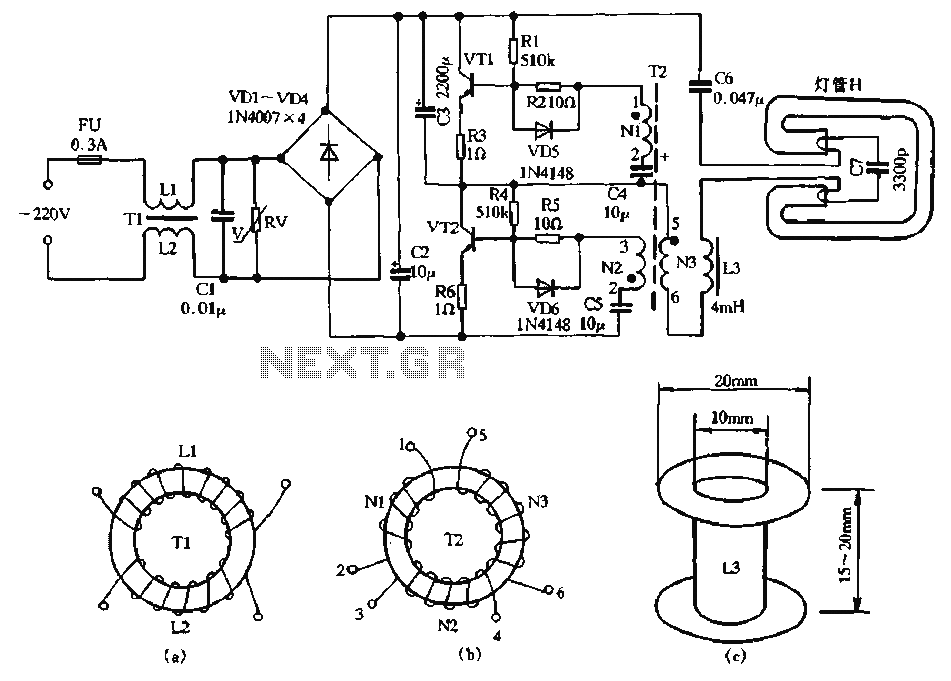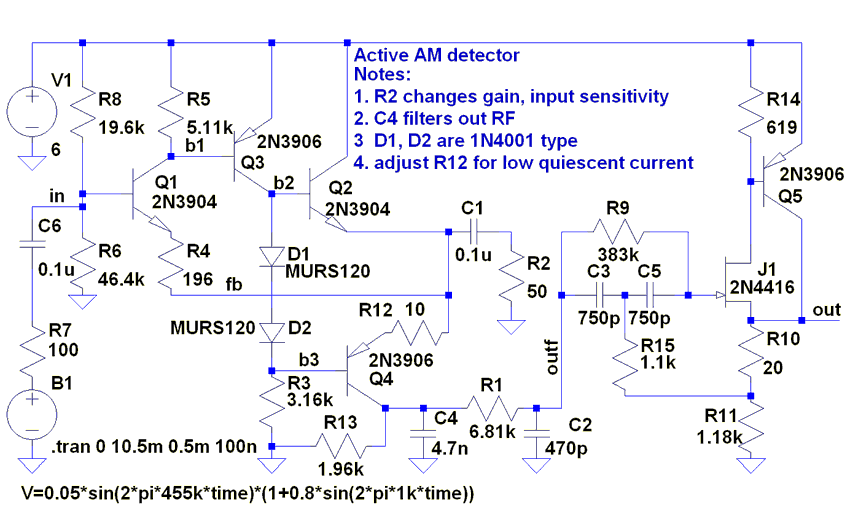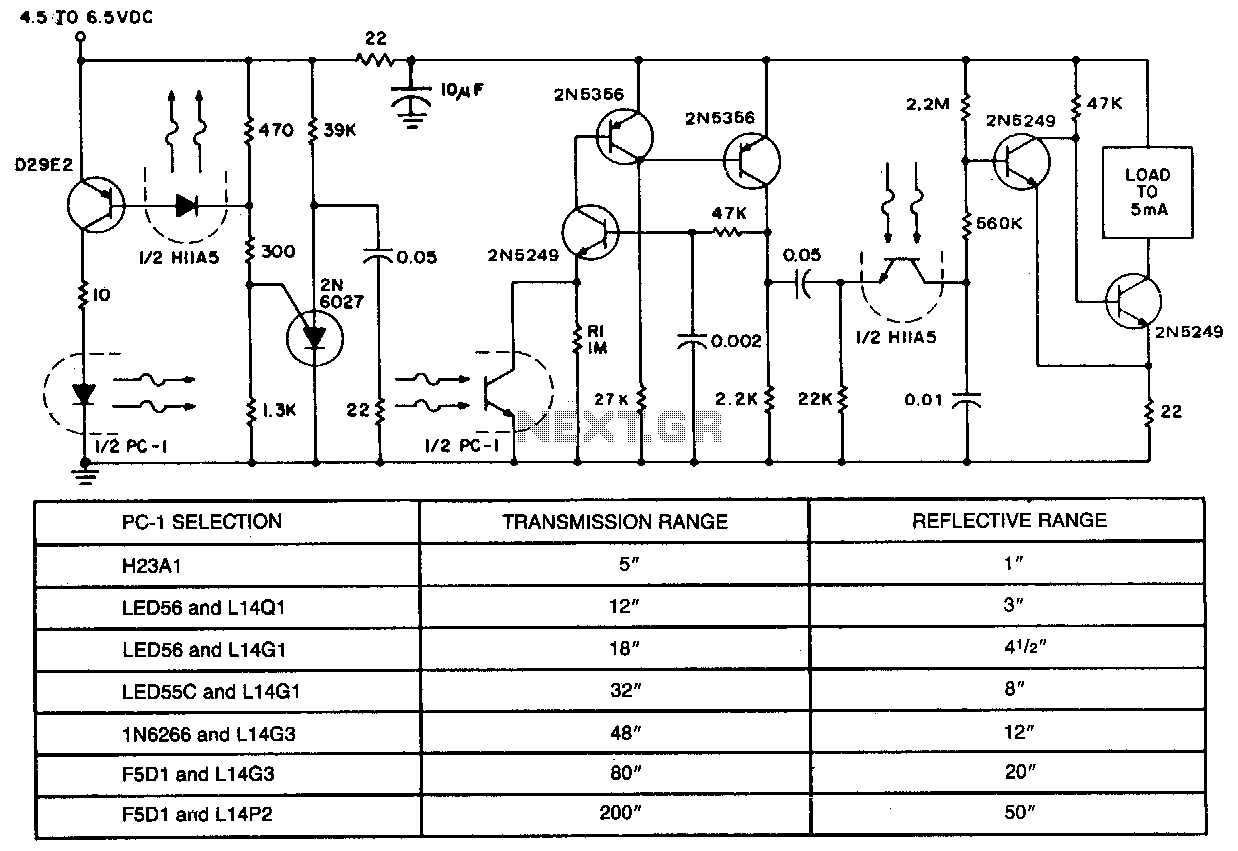
Energy Leak Detector

This sensitive circuit functions as a comparator, detecting minor temperature variations relative to the ambient temperature. It was primarily designed to identify drafts around doors and windows that lead to energy loss, but it can also be utilized in various applications where a precise temperature change detector is required. Two LEDs indicate whether the temperature change is above (Red LED) or below (Green LED) the ambient temperature. IC1 serves as a bridge detector and amplifier: its output voltage increases with rising temperatures and decreases with falling temperatures. This is due to the negative temperature coefficient (NTC) resistor R2, which decreases its resistance as the temperature rises, thereby unbalancing the bridge formed by resistors R1, R2, R4, and R5. IC2A and IC2B constitute a window comparator, while R8 functions as the sensitivity control. Prior to initiating a measurement, the circuit must be balanced using R1 to ensure that both LEDs remain off. Setting R8 to zero resistance maximizes circuit sensitivity, causing one of the LEDs to illuminate upon detecting even a slight temperature difference. Increasing the resistance value of R8 reduces the circuit's sensitivity.
This circuit employs a bridge configuration using resistors R1, R2, R4, and R5 to create a balanced condition under stable ambient temperature conditions. The NTC resistor R2 is critical as it exhibits a decrease in resistance with an increase in temperature, which introduces an imbalance in the bridge network. This imbalance is detected by IC1, which amplifies the resulting voltage change and outputs it to the subsequent comparator stage formed by IC2A and IC2B.
The window comparator configuration allows the circuit to differentiate between temperature increases and decreases, providing distinct visual signals through the two LEDs. The Red LED illuminates when the temperature exceeds the set threshold, while the Green LED lights up when the temperature falls below it. The sensitivity of the circuit is adjustable via R8, allowing for calibration based on specific application requirements. The balancing procedure using R1 is essential for accurate operation, ensuring that the system is properly set before any measurements are taken.
In practical applications, this circuit can be utilized in energy management systems, HVAC controls, and environmental monitoring, where detecting small temperature changes is crucial. Its design allows for flexibility in sensitivity adjustments, making it suitable for a wide range of scenarios beyond just detecting drafts. The use of standard components such as operational amplifiers and resistors ensures ease of implementation and reliability in various electronic designs.This sensitive circuit is basically a comparator, detecting very slight temperature changes in respect to the ambient temperature. It was primarily intended to detect draughts around doors and windows that cause energy leaks but can be used in many other ways, when a sensitive temperature change detector is needed.
Two LEDs are used to signal if t he temperature change is pointing above (Red LED) or below (Green LED) the ambient temperature. IC1 acts as a bridge detector and amplifier: its output voltage raises when temperature increases and vice-versa. This happens because the n. t. c. resistor R2 reduces its resistance value as temperature increases and vice-versa, therefore unbalancing the bridge formed by R1, R2, R4, R5.
IC2A and IC2B form a window comparator and R8 is the sensitivity control. Before starting a measurement the circuit must be balanced by means of R1 in order to obtain that both LEDs are off. If R8 is set to zero resistance the circuit sensitivity will be at maximum and one of the LEDs will illuminate when a very slight difference in temperature will be detected.
As R8 value is increased the circuit sensitivity will decrease. IC1 acts as a bridge detector and amplifier: its output voltage raises when temperature increases and vice-versa. This happens because the n. t. c. resistor R2 reduces its resistance value as temperature increases and vice-versa, therefore unbalancing the bridge formed by R1, R2, R4, R5.
IC2A and IC2B form a window comparator and R8 is the sensitivity control. Before starting a measurement the circuit must be balanced by means of R1 in order to obtain that both LEDs are off. If R8 is set to zero resistance the circuit sensitivity will be at maximum and one of the LEDs will illuminate when a very slight difference in temperature will be detected.
As R8 value is increased the circuit sensitivity will decrease. 🔗 External reference
This circuit employs a bridge configuration using resistors R1, R2, R4, and R5 to create a balanced condition under stable ambient temperature conditions. The NTC resistor R2 is critical as it exhibits a decrease in resistance with an increase in temperature, which introduces an imbalance in the bridge network. This imbalance is detected by IC1, which amplifies the resulting voltage change and outputs it to the subsequent comparator stage formed by IC2A and IC2B.
The window comparator configuration allows the circuit to differentiate between temperature increases and decreases, providing distinct visual signals through the two LEDs. The Red LED illuminates when the temperature exceeds the set threshold, while the Green LED lights up when the temperature falls below it. The sensitivity of the circuit is adjustable via R8, allowing for calibration based on specific application requirements. The balancing procedure using R1 is essential for accurate operation, ensuring that the system is properly set before any measurements are taken.
In practical applications, this circuit can be utilized in energy management systems, HVAC controls, and environmental monitoring, where detecting small temperature changes is crucial. Its design allows for flexibility in sensitivity adjustments, making it suitable for a wide range of scenarios beyond just detecting drafts. The use of standard components such as operational amplifiers and resistors ensures ease of implementation and reliability in various electronic designs.This sensitive circuit is basically a comparator, detecting very slight temperature changes in respect to the ambient temperature. It was primarily intended to detect draughts around doors and windows that cause energy leaks but can be used in many other ways, when a sensitive temperature change detector is needed.
Two LEDs are used to signal if t he temperature change is pointing above (Red LED) or below (Green LED) the ambient temperature. IC1 acts as a bridge detector and amplifier: its output voltage raises when temperature increases and vice-versa. This happens because the n. t. c. resistor R2 reduces its resistance value as temperature increases and vice-versa, therefore unbalancing the bridge formed by R1, R2, R4, R5.
IC2A and IC2B form a window comparator and R8 is the sensitivity control. Before starting a measurement the circuit must be balanced by means of R1 in order to obtain that both LEDs are off. If R8 is set to zero resistance the circuit sensitivity will be at maximum and one of the LEDs will illuminate when a very slight difference in temperature will be detected.
As R8 value is increased the circuit sensitivity will decrease. IC1 acts as a bridge detector and amplifier: its output voltage raises when temperature increases and vice-versa. This happens because the n. t. c. resistor R2 reduces its resistance value as temperature increases and vice-versa, therefore unbalancing the bridge formed by R1, R2, R4, R5.
IC2A and IC2B form a window comparator and R8 is the sensitivity control. Before starting a measurement the circuit must be balanced by means of R1 in order to obtain that both LEDs are off. If R8 is set to zero resistance the circuit sensitivity will be at maximum and one of the LEDs will illuminate when a very slight difference in temperature will be detected.
As R8 value is increased the circuit sensitivity will decrease. 🔗 External reference





